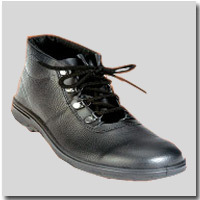Electrical Safety Shoes Explained

Electrical Safety Shoes
Electricians and other personnel who work with electrical equipment can not only fall victim to electrical shock, but from objects that could roll or fall onto their feet that could either penetrate or crush them. Let’s not forget the increased exposure to corrosive materials and hot substances. For increased electrical safety, non-conductive electrical safety shoes should be worn—particularly if work is being performed on electrical equipment. On some occasions where static electricity might be a factor, conductive footwear may be required.
The Occupational Safety and Health Administration (OSHA) say that electrical safety shoes must meet the minimum standards set by the American National Standards Institute (ANSI). ANSI-approved electrical safety shoes contain compression and impact protection and a protective toe.
Electrical Safety Shoes – Types of Electrical Safety Shoe Protection
The type and the level of protection of electrical safety shoes aren’t always the same. Before any electrical safety shoes are purchased, these factors should be determined by either checking the label or by contacting the manufacturer.
Some of the different types of electrical safety shoe protection include:
- Metatarsal guards so that the instep area of the foot is protected from compression and impact. These guards can be found in steel, aluminum, plastic or fiber.
- Combination shin and foot guards so that the feet and lower legs are protected. If more protection is desired, then this combination can be used with toe guards.
- Toe guards so that the toes are protected from compression and impact hazards. Toe guards can be worn over the toes of regular shoes and are often made of plastic, aluminum or steel.
Electrical Safety Shoes – Static Electricity Protection
Conductive electrical safety shoes must be worn in areas where explosions can happen. One spark from static electricity from human clothing is enough to start a fire or cause combustible materials to explode, but conductive electrical safety shoes prevent the build-up of static electricity on the human body thus lowering the risk of explosions. Conductive electrical safety shoes should never be worn when work is being done on electrical equipment.
Electrical Safety Shoes – Electrical Hazard Protection
Nonconductive electrical safety shoes must be worn by any workers who are at risk to an electrical hazard. Safety-toe shoes for electrical hazards, which can protect against electrical circuits up to 600 volts in dry conditions, are nonconductive electrical safety shoes that won’t complete an electrical circuit to the ground. These electrical safety shoes are recommended for usage with other insulating equipment that can lower the risk of an electrical hazard. However, the safety-toe shoe’s insulating protection can lose its effectiveness if the soles are worn through, the shoes become wet, or if an employee touches a grounded, conductive item. Nonconductive electrical safety shoes should never be worn in areas where explosions could occur.
- Read More Here: Arc Flash and Electrical Safety
- Read More Here: Electrical Safety Training
- Read More Here: Electricity
For more information, see:
On-site training
Interested in cost effective, professional on-site electrical smart grid training?
We can present an On-site Training Course to your electrical engineering and maintenance staff, on your premises, tailored to your specific equipment and requirements. Click on the link below to request a FREE quotation.
Live Online Electrical Training Schedule
October 2025
November 2025
- Power Transformer Maintenance Training
- NFPA 70b Training - Electrical Maintenance
- Emergency Generators & Standby Power Systems
- 2024 CE Code - Changes and Fundamentals
- 2024 CE Code - Combined Course: Changes/Fundamentals and Calculations
- Arc Flash Training - CSA Z462 Electrical Safety
- Lightning Protection Systems Training For Utility, Industrial, Commercial & Institutional power systems
- CE Code Calculations: Practical Applications and Advanced Techniques
- Substation Relay Protection Training
- Energy Storage Systems Course
Arc Flash Group Training

We can present this Course to your electrical engineering and maintenance staff, on your premises, tailored to your specific equipment and requirements. We are ready to help design this program for you. Click on the link below to request a FREE quotation.
